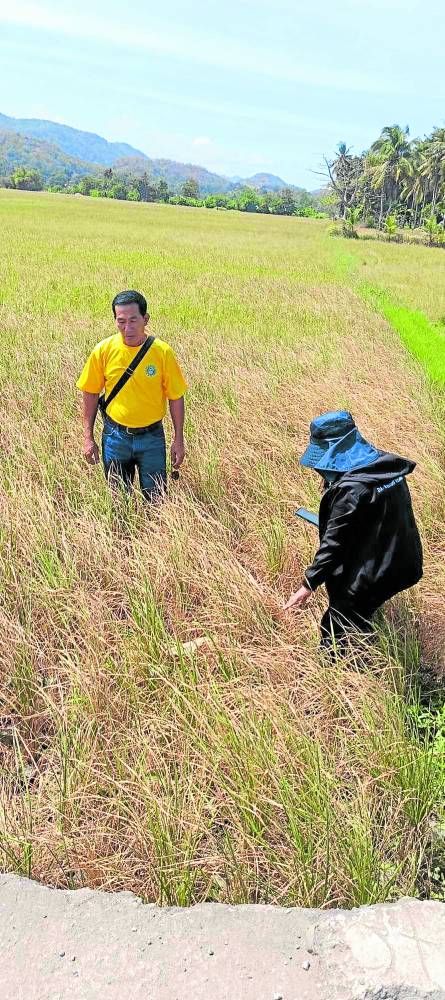Negros Occidental farmers lose P7M to dry spell

PARCHED Personnel of the Office of the Provincial Agriculturist
in Negros Occidental inspect a rice field hit by the dry spell
in Cauayan town. —PHOTO COURTESY OF THE OFFICE OF THE PROVINCIAL
AGRICULTURIST
BACOLOD CITY—Rice farmers in two towns and a city in Negros Occidental lost at least P7 million as the dry spell caused by the El Niño weather phenomenon hits farms in the province, reports from the Department of Agriculture (DA) showed.
Dina Genzola, officer in charge of the Office of the Provincial Agriculturist, said 117.22 hectares of rice farms had started to dry up, affecting at least 143 farmers in 11 barangays.
Reports from the provincial agriculture office said Cauayan town posted P4.105 million in losses covering 52 ha; Himamaylan City, P2.414 million affecting 59.22 ha; and Isabela town, P560,250 with 6 ha affected.
Genzola said they sent agriculture extension workers to validate the damage reported by the three local governments.
“The crops are either in vegetative or harvestable stage. You can see the soil is cracking from the dry spell and plants have wilted,” she said.
Article continues after this advertisementMost of the affected areas are rainfed or those that rely mainly on rainfall for water.
Article continues after this advertisementGenzola said farmers covered by the Philippine Crop Insurance Corp. would be qualified to avail of crop insurance.
Preparation
The provincial government has also allocated funds for the crop insurance program.
According to Gov. Eugenio Jose Lacson, Negros Occidental is bracing for “a very hard” El Niño and will ensure that irrigated rice lands have adequate water supply.
Lacson said 60 percent of the province’s irrigated rice lands produce the bulk of the province’s rice needs.
“The province is 84-percent rice sufficient. We have to maximize the use of available water and avoid wastage,” Lacson said.
Earlier, the Department of Science and Technology announced that at least 65 provinces might experience moderate-to-severe drought conditions from February to May due to a “strong” El Niño, a climate pattern characterized by the unusual warming of surface waters in the eastern tropical Pacific Ocean.
In a briefing in Malacañang in December, Science and Technology Secretary Renato Solidum Jr. said: “By the end of May, 77 percent of the provinces in the country will have the potential for drought. That would be around 65 provinces and 7 percent potential for a dry spell or around six provinces.”
Also in December, President Marcos met with officials of the DA, the National Economic and Development Authority, the Department of Environment and National Resources and the National Irrigation Administration and ordered them to categorize actions into short- and medium-term to mitigate the impact of El Niño.